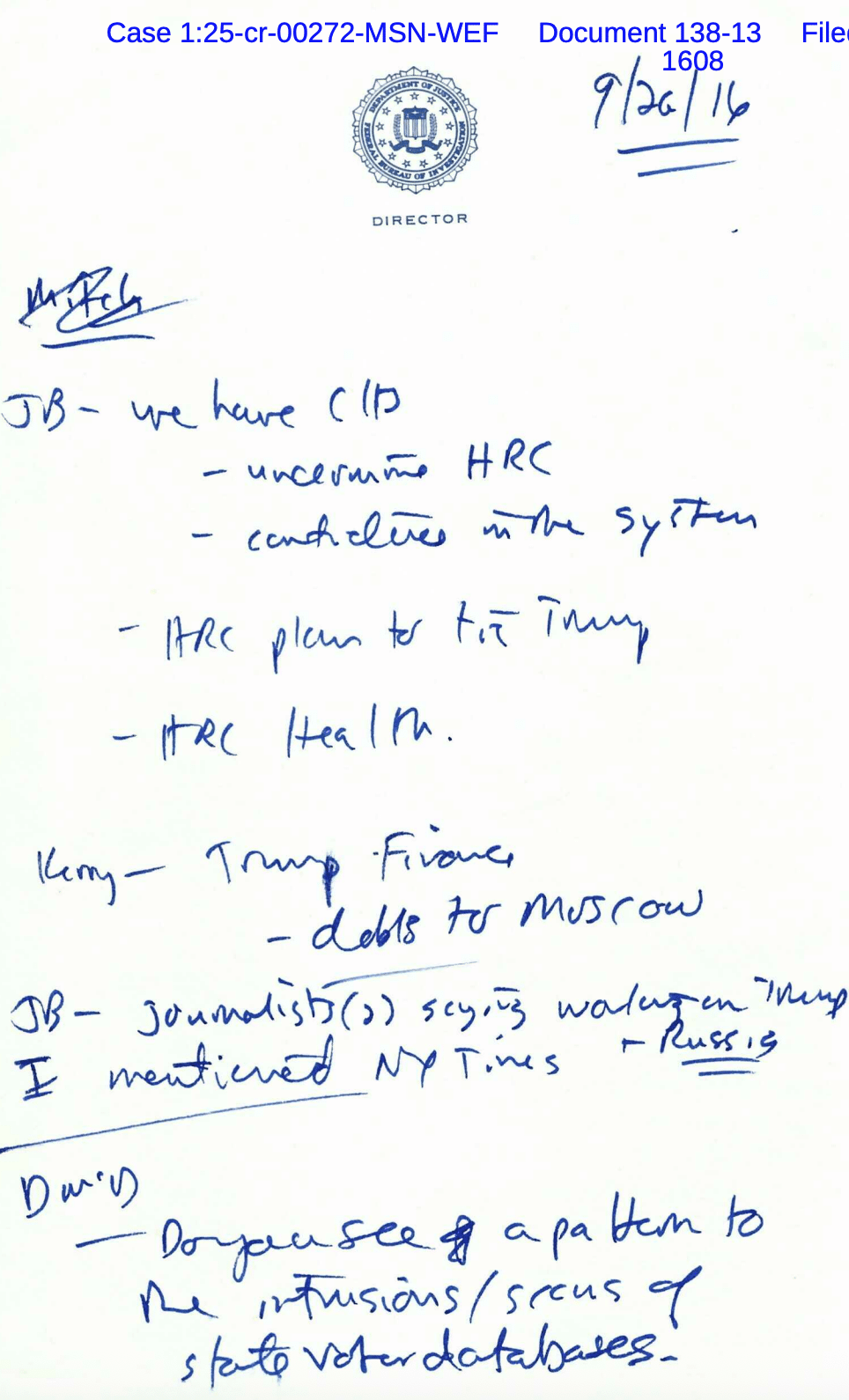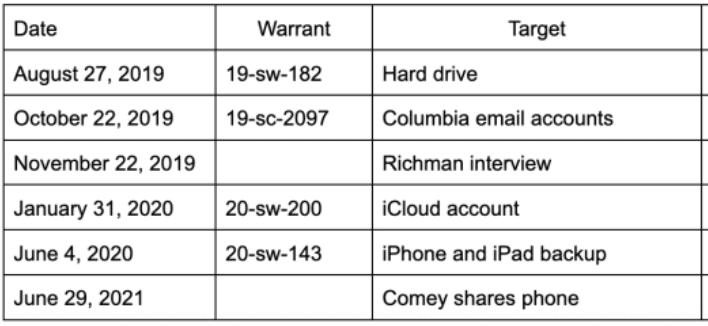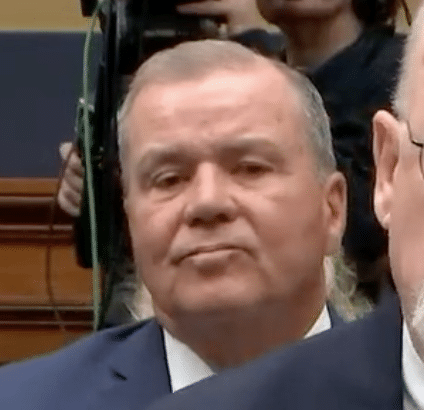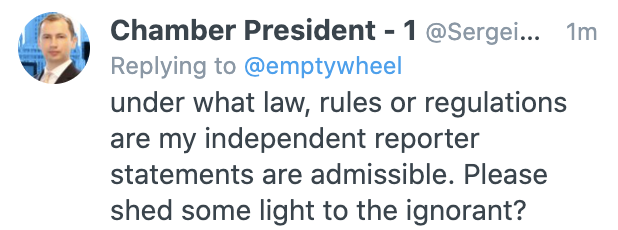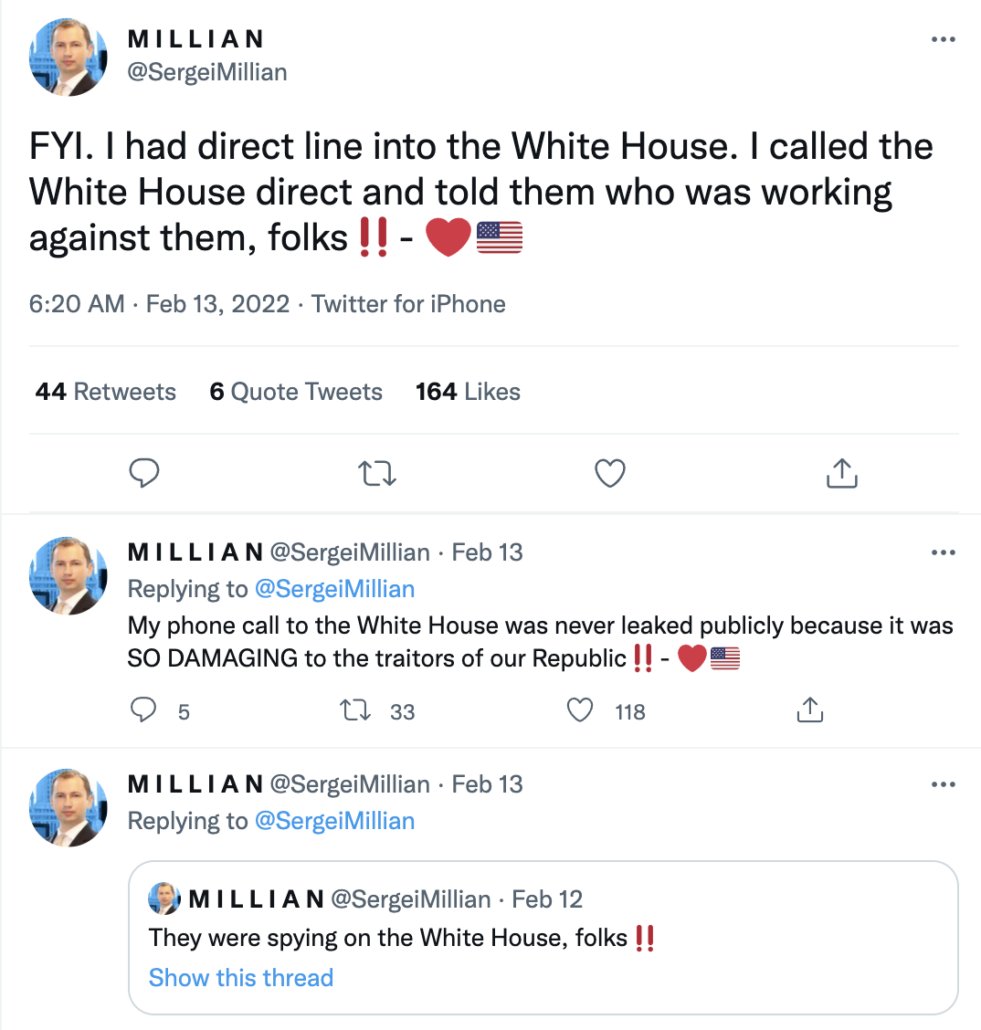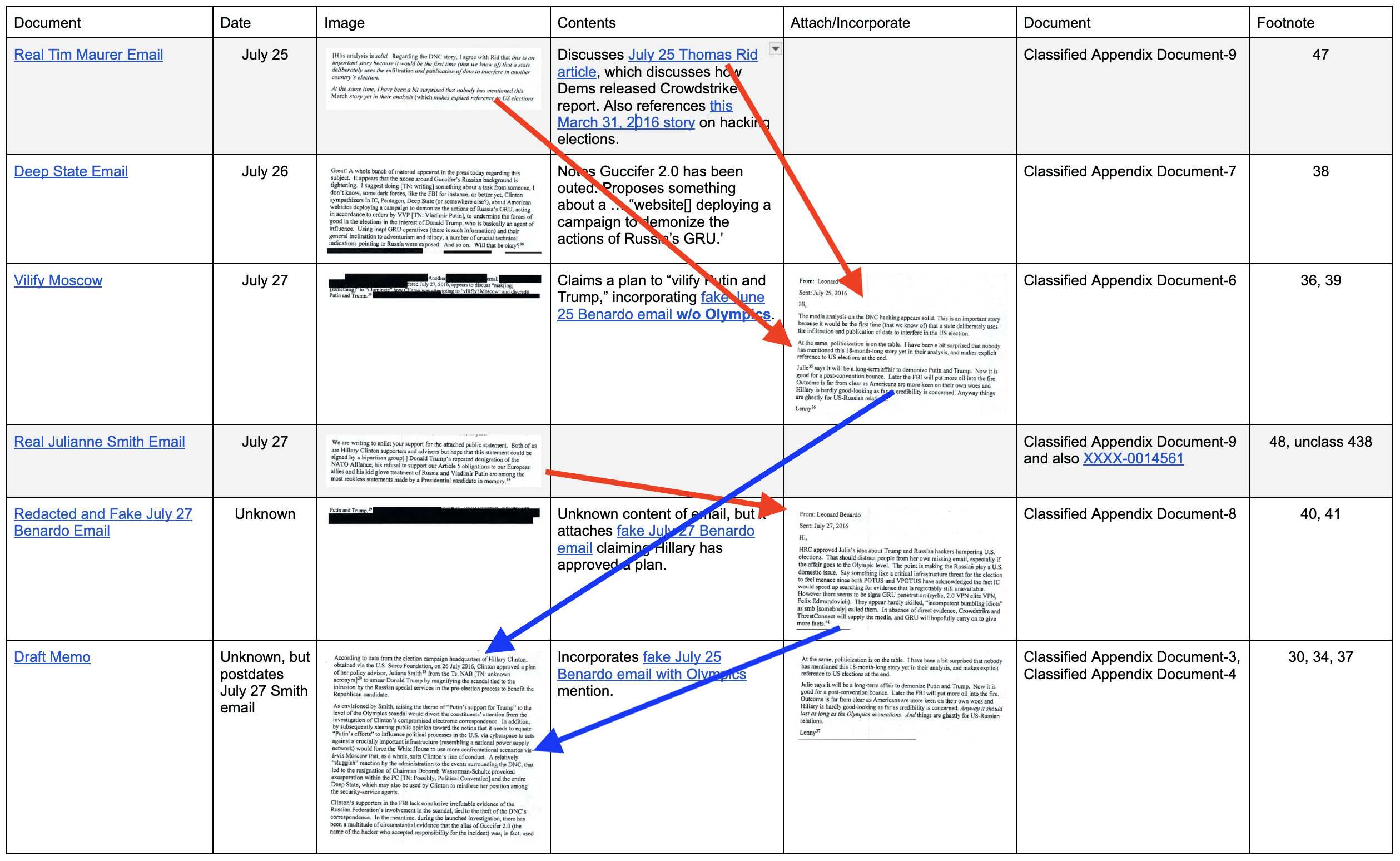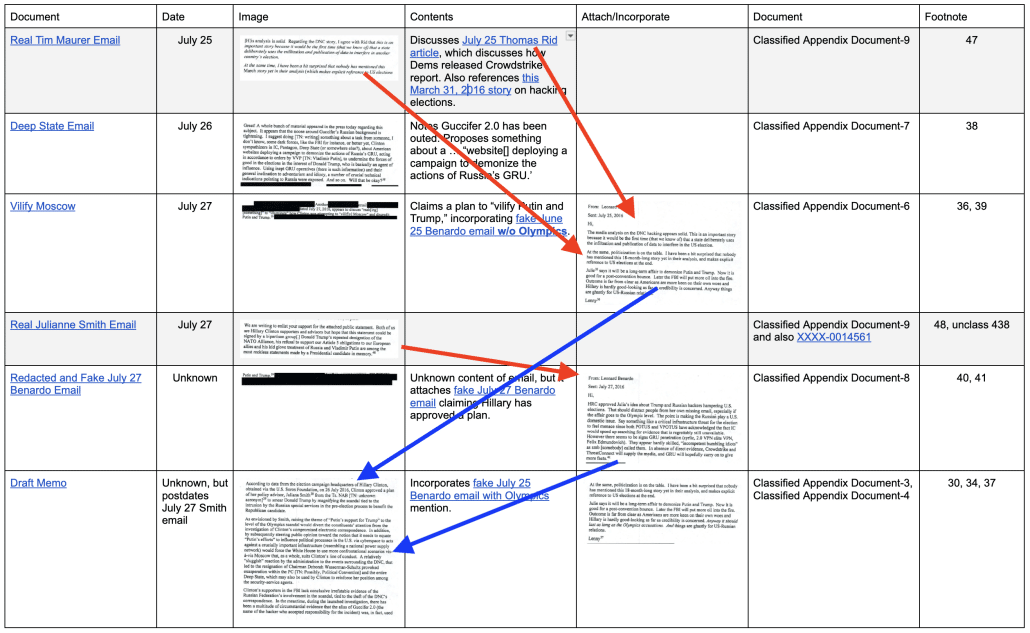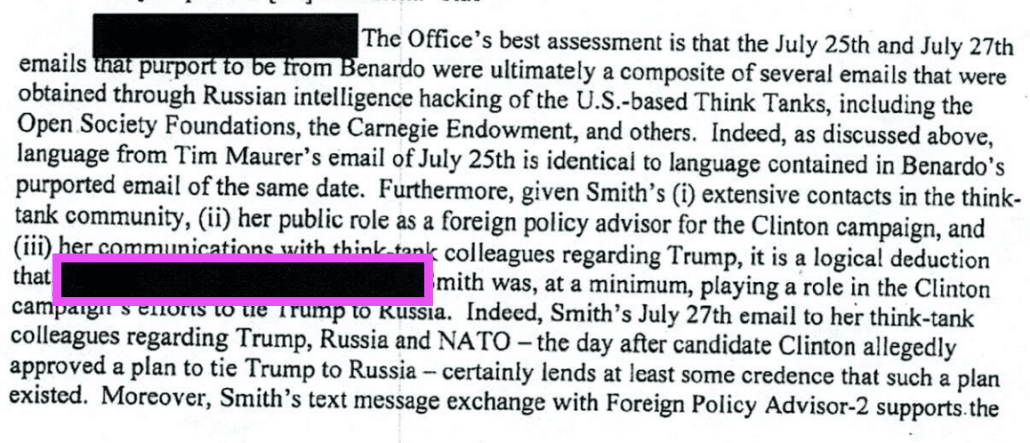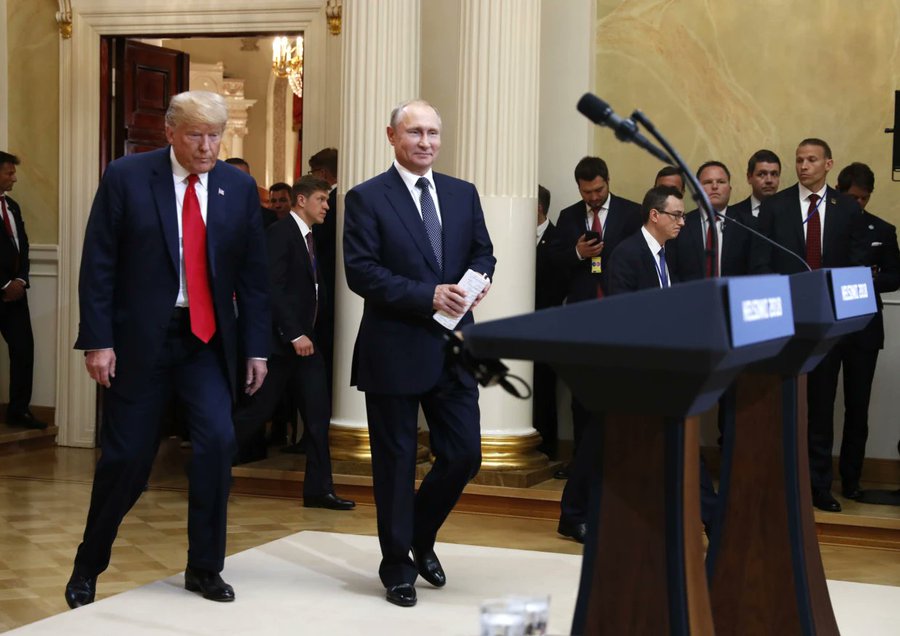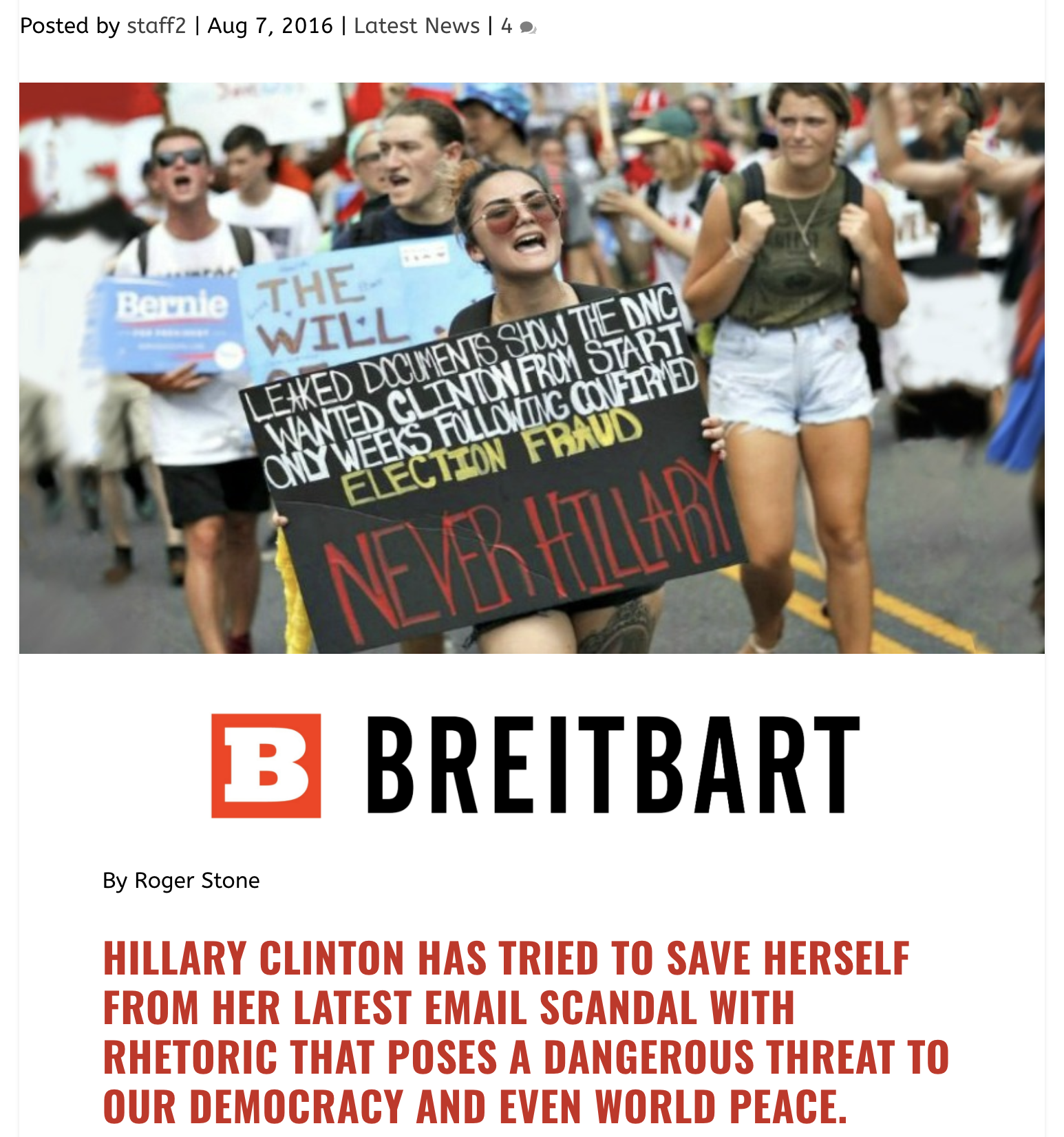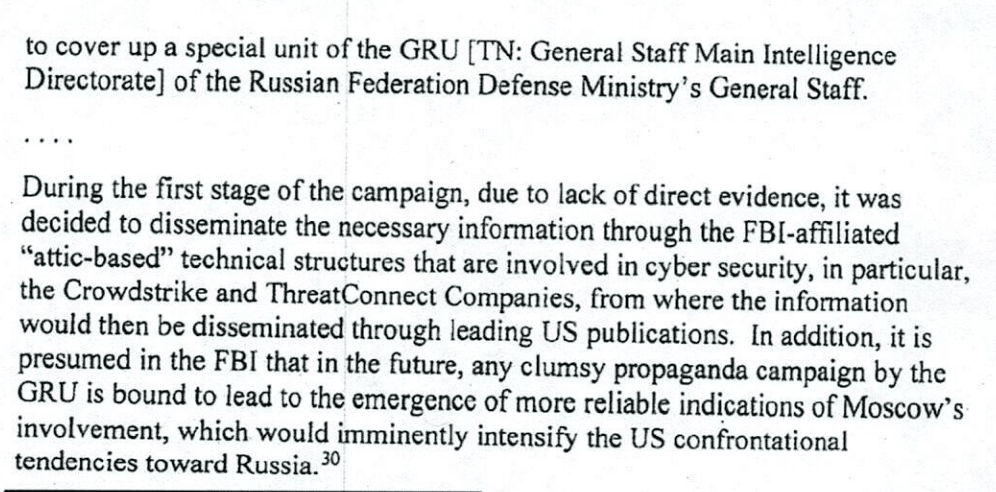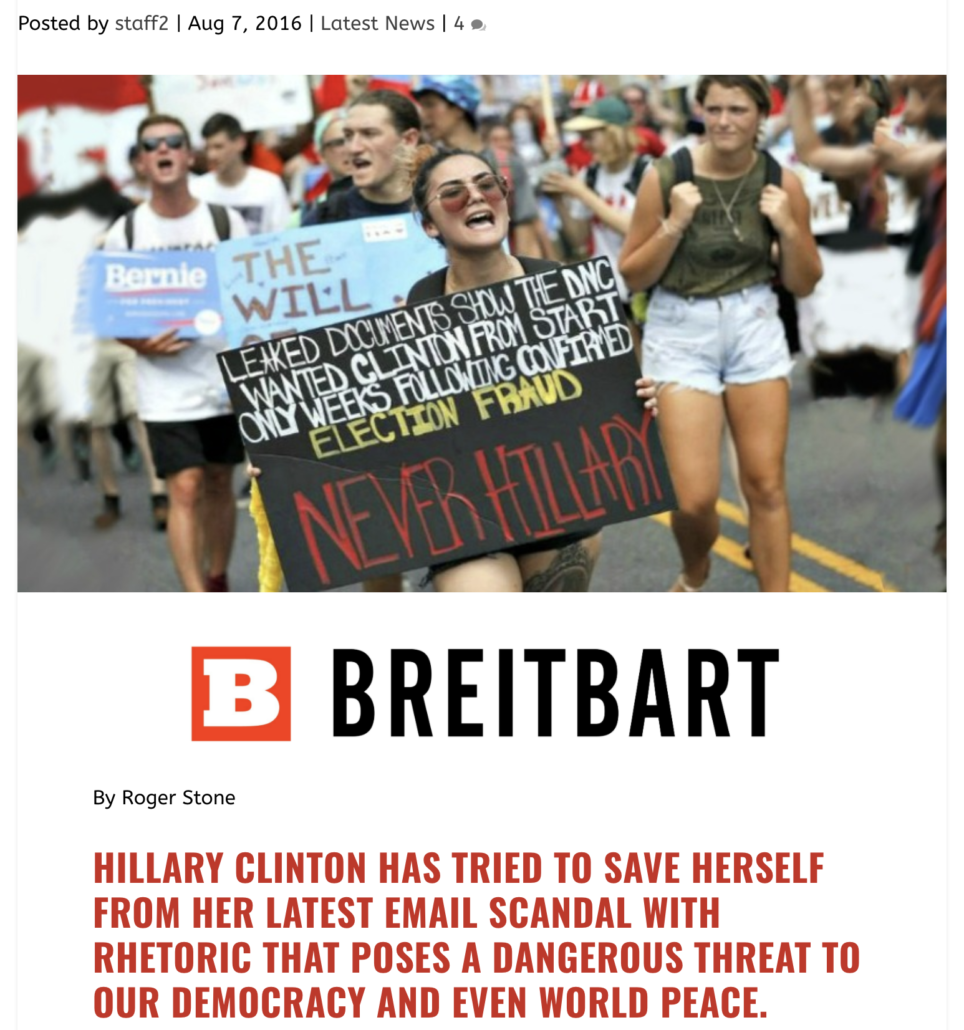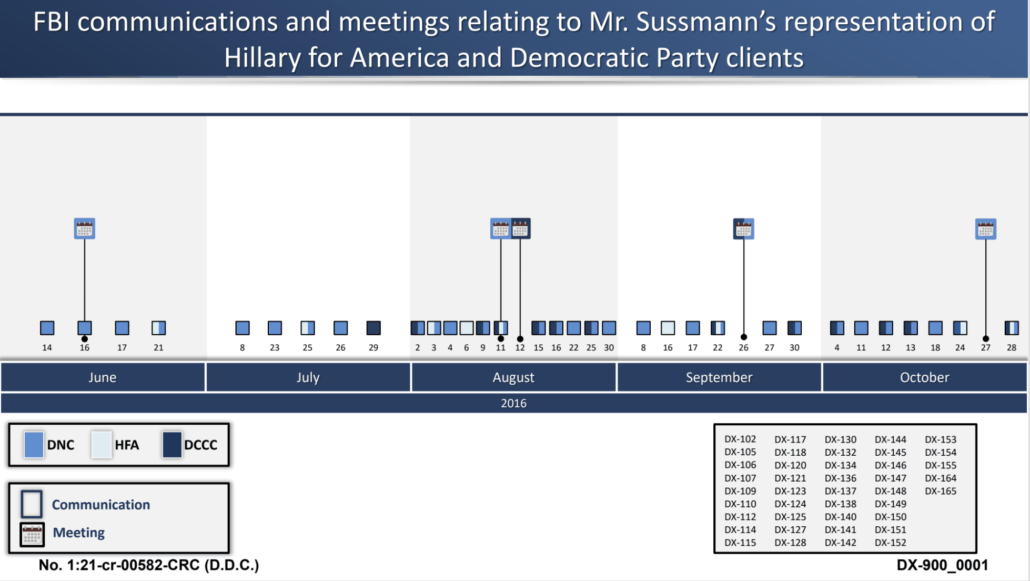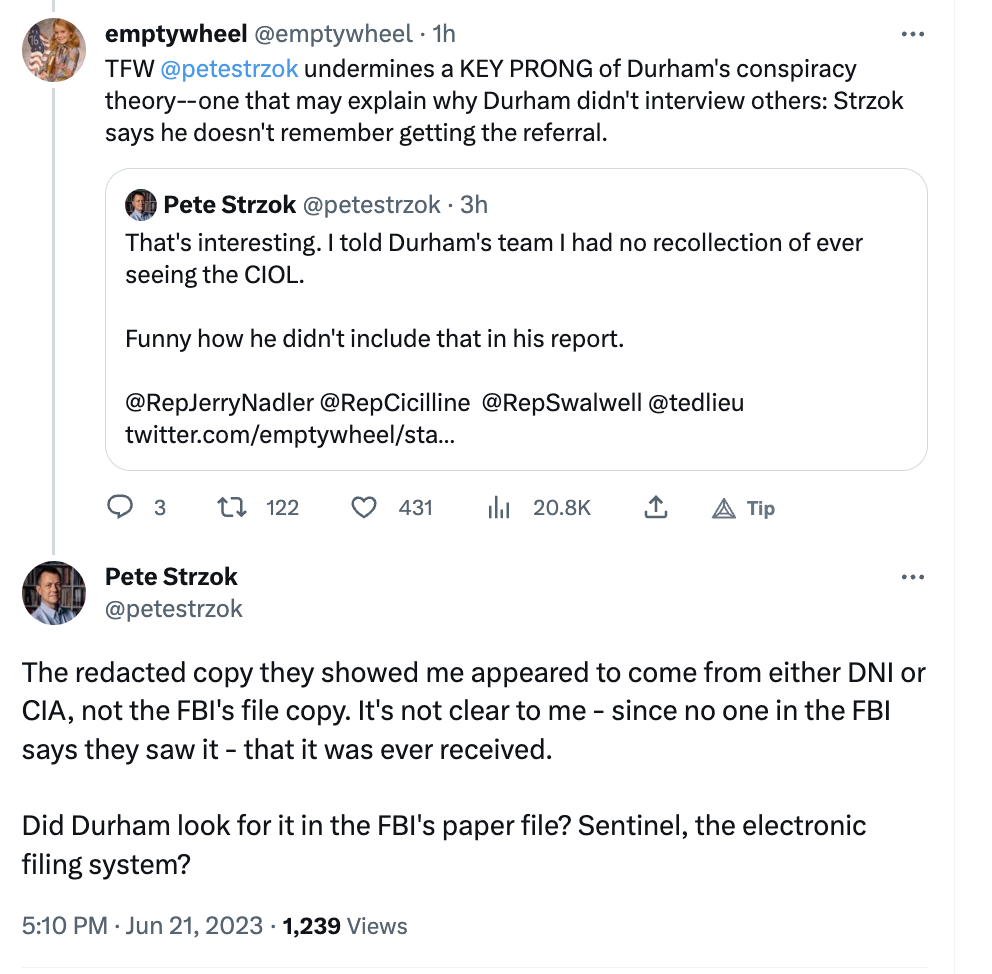The Graymail Cometh
I’ve written extensively about how Kash Patel and John Durham chased a particular intelligence report — one we now know to have been based on Russian fabrications — for four years.
Kash, John Ratcliffe, Durham, his lead investigator Jack Eckenrode (who leads this investigation), Bill Barr — all of them! — believed that because the FBI received a single intelligence report repeating a Russian claim that Hillary planned to hold Trump accountable for his ties to Russia, it was proof that Hillary had intentionally fabricated the Steele dossier (disinformation into which was probably injected by Paul Manafort buddy Oleg Deripaska) and the Alfa Bank anomalies.
The case against Jim Comey renews that goose chase, perhaps (because Durham concluded it was likely fabricated) criminally so.
In his bid to obtain the grand jury transcripts submitted yesterday, Comey laid out how important it was for him to see how Lindsey Halligan instructed the jury on this matter, especially given that the grand jury rejected the charge specifically pertaining to that intelligence, but Loaner AUSAs plan to use it to prove Count Two of the existing indictment. As part of that discussion, he lays out how obscene it was to even charge him for not remembering something simply because Kash and Ratcliffe had developed an obsession over it.
Note, I have generally referred to that intelligence report as the “Clinton Plan,” which is how Durham referred to it, though without the scare quotes making clear that Durham himself fabricated parts of this theory. Comey, in his filings, uses the FBI term for all such referrals, CIOL (Counterintelligence Operational Lead).
Comey’s description starts with a detail I should have known, but did not: When Comey was asked, three times during the September 30, 2020 hearing, about the “Clinton Plan” CIOL, he had not been shown it.
On September 30, 2020, Mr. Comey testified before the Senate Judiciary Committee about the Crossfire Hurricane counterintelligence investigation into alleged links between President Trump’s 2016 campaign and the Russian government. See Oversight of the Crossfire Hurricane Investigation: Day 3, Hearing Before the U.S. Senate Committee on the Judiciary, 116th Cong. (Sept. 30, 2020), http://bit.ly/4o2ekHb. The night before, he was sent a copy of the Ratcliffe Letter, described above, which purported to summarize the September 7, 2016 CIOL in one sentence. Mr. Comey was not provided an opportunity to review the September 7, 2016 CIOL at issue prior to his testimony.
Ratcliffe had sent Lindsey Graham a misleading letter about it the night before the hearing, but he didn’t release the memo itself (which was itself redacted in a misleading way, and then shared with the Federalist) for another week. I first posted about it on October 11 of that year.
Nevertheless, Lindsey Graham highlighted it in the hearing and then Josh Hawley followed up. The focus on the referral was an ambush, probably intended to support the Durham investigation. And that’s what Kash is trying to criminalize, because doing so sustains his batshit insane theory that Hillary was treated better than Trump in the 2016 election when two criminal investigations into her dominated and the investigation into Trump’s aides remained secret.
To make things worse, Trump is trying to criminalize something which there’s no evidence Comey ever saw (Comey lays this out without even mentioning that Durham couldn’t find any proof that anyone else had seen it, either).
There is no evidence whatsoever that Mr. Comey received the CIOL at issue, much less that he reviewed it. The materials in discovery make clear that every day, numerous CIOLs come to the FBI addressed to the Director—from a variety of federal agencies in a variety of formats—and are routed to employees other than the Director. Because the Midyear Exam investigation had been closed for more than two months, there is no reason to believe that any CIOL related to Ms. Clinton would have been sent to Mr. Comey (and the government has produced no proof that it was). There is no electronic trail showing that Mr. Comey received the CIOL at issue. There is no paper trail showing that he received it. And there is no witness who says that Mr. Comey either received it or discussed it with him. Full stop.
This total lack of evidence is extremely troubling in light of credible press reporting that not only does a declination memorandum exist in this case,11 but it made clear that with respect to the CIOL in particular, a prior investigation found that Mr. Comey’s statement could not support a false-statement charge because there was insufficient evidence Mr. Comey had ever seen the CIOL.12 Ms. Halligan was also reported to have been advised by career prosecutors in that declination memorandum that “seeking the charges would violate DOJ policy, raise serious ethics issues, and risk being rejected by the grand jury.” Id. 13
11 The government’s refusal to answer basic questions about the existence of this declination memorandum and decision to hide behind a flimsy claim of privilege to stonewall the Court’s inquiries, see ECF No. 207, should be taken as confirmation that such a memorandum exists. See ECF No. 174 at 21.
12Katherine Faulders, et al., Ex-special counsel John Durham undercut case against James Comey in interview with prosecutors: Sources, ABC News (Oct. 6, 2025), https://perma.cc/M2JC-CQGQ.
13 Katherine Faulders, et al., Prosecutors’ memo to new US attorney found no probable cause to charge James Comey: Sources (Sept. 25, 2025), https://perma.cc/8KT5-LHAG.
As noted, this was a key part of Comey’s bid to get the grand jury transcripts, something that goes to the heart of the problem with simply cut-and-pasting the two true billed charges into a new indictment.
But as part of his (far less interesting) reply motion for a Bill of Particulars, he also includes all the discovery requests he has submitted (October 2, October 29, November 12, November 19). They hint at another way this prosecution might go away (and Comey’s post-exoneration retaliation might flourish), on top of the 14 ways we’ve already talked about: with discovery requests with which prosecutors will really not want to comply, or cannot, either because of bulk, classification, or destruction.
In the latter category, for example, Comey reveals an October 12 FBI 302 describing that DC USAO destroyed records relating to journalists when the Arctic Haze investigation was closed.
An FBI 302 Report, dated October 12, 2025, reports that “the District of Columbia United States Attorneys Office [was] ‘freaking out’ when the [Arctic Haze] case was declined for prosecution and in the process of being closed, with an Assistant United States Attorney telling [the lead agent in the Arctic Haze investigation] to ensure that any grand jury materials relating to members of the media were destroyed.” See FD-302 Report Serial 110 at -26505.
Lindsey’s Loaner AUSAs say that’s not true.
In an email on November 20, 2025 at 10:29 AM ET, the government represented that the 302 was inaccurate and the records had not, in fact, been destroyed. Mr. Comey reserves his rights with respect to the government’s potential spoliation of exculpatory evidence and will further investigate the government’s claim.
Comey also, just Wednesday, asked for the complete case file for the Arctic Haze, Durham, and this investigation (why he doesn’t have the latter two months after indictment I don’t know).
The Arctic Haze case file will lay out not just how Bill Barr focused exclusively on Comey (which I noted here) as opposed to others who might have been trying to damage him, but would name the Republican(s) who would have been the focus if he had not done so.
The Durham case file would explain why Andrew DeFilippis left DOJ quickly and quietly in the middle of the investigation. It would show that Durham lied in his report about how many FBI sources he had asked about the “Clinton Plan” CIOL, partly in an attempt to hide how clear it was that no one had seen this. It might show which Ukrainian Russian agents Durham and Barr and Jack Eckenrode consulted during the investigation and whether they also consulted Oleg Deripaska. It would either reveal the nature of the tip about Trump corruption that Italy gave to Durham or make clear that Durham hadn’t actually chased it down.
Importantly, it would also include all the evidence that shows Durham and Durham’s lead investigator turned Kash’s senior advisor, Jack Eckenrode, saw confirming that he had been chasing Russian disinformation for years, even while failing to establish any proof that FBI had actually received it. That evidence would be important to lay out how the continued pursuit of this by Kash and Eckenrode is a crime, at least according to Durham’s logic.
Holy hell I’d love to see the full Durham case file.
But the request that might really sink this prosecution, if 14 other things don’t first, is Jim Comey’s request for (1) all the CIOLs he received between January 1, 2016 (when the first SVR reports pertinent to the Clinton email investigation came in) and September 30, 2016, (2) all the intelligence he received pertaining to the Clinton email investigation or Crossfire Hurricane in that same period, and (3) all communications he received for a narrower period, July 1, 2016 to September 30, 2016.
If the government intends to present evidence as part of its case in chief at trial regarding the CIOL dated September 7, 2016 that Mr. Comey was questioned about in the September 30, 2020 Senate Judiciary Committee hearing, Mr. Comey is entitled to any and all documents that would rebut the inference that this CIOL was memorable to him as of September 30, 2020. Therefore, to the extent Count Two (or any other aspect of the government’s case in chief) is premised on the September 7, 2016 CIOL, in addition to the standard Rule 16 discovery that we are entitled to receive promptly, we are entitled to receive the following categories of documents pursuant to Rule 16 and Brady and its progeny, all of which are material to Mr. Comey’s ability to defend this case in pretrial motion practice and/or at trial:
(1) Any and all documents reflecting Mr. Comey’s receipt or review of CIOLs concerning the Midyear Exam investigation, Hillary Clinton, or the Crossfire Hurricane investigation between January 1, 2016 and September 30, 2016, including but not limited to:
(a) The CIOLs themselves; and
(b) Documentation reflecting Mr. Comey’s receipt or review thereof;
(2) Any and all documents reflecting Mr. Comey’s receipt or review of classified information concerning the Midyear Exam investigation, Hillary Clinton, or the Crossfire Hurricane investigation between January 1, 2016 and September 30, 2016;
(3) Any and all documents reflecting discussion involving Mr. Comey of CIOLs concerning the Midyear Exam investigation, Hillary Clinton, or the Crossfire Hurricane investigation between January 1, 2016 and September 30, 2016;
(4) Any and all documents reflecting discussion involving Mr. Comey of classified information concerning the Midyear Exam investigation, Hillary Clinton, or the Crossfire Hurricane investigation between January 1, 2016 and September 30, 2016; and
(5) Any and all communications or documents received by Mr. Comey in his capacity as Director of the FBI between July 1, 2016 and September 30, 2016. “Communications” as used in this subrequest five includes, but is not limited to:
(a) Emails;
(b) Phone calls;
(c) Text messages;
(d) Records of oral communications;
(e) Meeting invitations and calendar entries; and
(f) Hard copies of written communications delivered to Mr. Comey or his staff.
This is, on one hand, totally justifiable, because it would show just how unremarkable the CIOL that the current FBI Director has obsessed about for six years is as compared to everything else that Comey saw in that period. It would show why it made sense that, in 2020, when sandbagged by a misleading letter, it was unsurprising that the “Clinton Plan” CIOL would not ring a bell, as Comey responded in the hearing.
On the other hand, it is classic graymail, the very defense strategy used by Scooter Libby a hundred (well, just twenty) years ago: a request for documents so sensitive and so voluminous that prosecutors would have an exceedingly difficult time complying.
Libby’s request was more frivolous than this one. He asked for PDBs, among the most sensitive intelligence documents out there, covering the period when he was targeting Valerie Plame through the period when he lied to Patrick Fitzgerald about doing so. Fitzgerald managed not just to get the discovery to Libby, but to get substitutions approved so Libby’s team could walk through how insignificant exposing a CIA officer was to him, given the issues he was dealing with at the time.
By comparison, Comey’s is totally reasonable, given what prosecutors are preparing to argue, that he should have remembered, in September 2020, either the CIOL he didn’t receive or a briefing, possibly from John Brennan, that mentioned it in passing weeks later.
But Comey’s request will be just as difficult to comply with (and will also flip the logic of the dumb burn bag investigation back onto investigators). Plus, Kash Patel won’t want to comply with this, because it would involve giving Jim Comey a ton of information about how real and pressing the Russian attack was in 2016, the one Kash’s entire career is built on diminishing.
It seems that Lindsey’s Loaner AUSAs are already trying to dodge this request. The most recent discovery letter, sent Tuesday, reveals that prosecutors are struggling to come with even the number of CIOLs Comey saw.
With respect to defense Category Twelve, which we understand from our November 12, 2025 meet and confer that you are working to provide relevant numbers with respect to, we seek to review the underlying CIOLs for 2016 in their entirety, and reserve our right to seek declassification of those CIOLs.
Tough shit, this letter says. We not only want the number, we want to see them, all of them, and we may demand you declassify them.
In October, ABC reported that one of the things in the declination memo — one of the reasons why career prosecutors said they could not charge this — was the difficulty in even identifying the number of things they’d have to show Comey.
Prosecutors further expressed concerns about the department’s ability to take the case to trial quickly due to problems identifying all the relevant materials that would need to be handed over to Comey’s lawyers, sources said.
This is what that concern looks like in real life.
And if Lindsey’s unlawful appointment or Trump’s clear malice or Lindsey’s suspected misconduct in the grand jury or her failure to actually get an indictment or Miles Starr’s breach of Comey’s privilege or their unwarranted searches or Ted Cruz’ prevarications and stupid questions or the destruction of exculpatory evidence or something else doesn’t make this prosecution go away beforehand, Lindsey’s Loaner AUSAs may one day give up.
Update: In a new filing, Comey asks for a delay of his deadline for identifying what classified information he’ll need to defend himself. Among the problems is DOJ has still not declassified the CIOL John Ratcliffe partly declassified 5 years ago.
First, the government must produce the classified discovery at issue. On October 29, 2025, and November 19, 2025, the defense made discovery and Brady requests to the government that called for the production of additional classified information and the declassification of certain materials. See ECF No. 204-2 (Requests Eleven and Twelve) and 204-4 (Request Fourteen). With respect to the defense’s requests, the government reported today, November 21, 2025, that they had requested authorization for the defense to have access to certain counterintelligence operational leads (“CIOLs”), but that they were held at high classification levels. Needless to say, to the extent Count Two relates to a CIOL, and Mr. Comey’s purported memory of a CIOL, it is necessary for the defense to review the CIOL and any other relevant CIOLs. That has not happened.
Discovery requests
Category One: Lindsey Halligan’s unlawful appointment (expanded to include WDVA)
Category Two: Lack of probable cause (expanded to include more prosecutors)
Category Three: Presentation to grand jury
Category Four: Vindictive prosecution (expanded to include comparators)
Category Five: Trump’s hostility to Jim Comey
Category Six: Prejudicial statements from Trump
Category Seven: Prior inconsistent statements from Andy McCabe
Category Eight: Other Rule 16 and Brady
[There’s no identifiable Category Nine]
Category Ten: Potential sources identified in leak investigations
Category Eleven: Privilege taint
Category Twelve: All CIOLs and communications
Category Thirteen: All evidence destroyed in Arctic Haze investigation
Category Fourteen: Full case files for Arctic Haze, Durham investigation, Jim Comey

